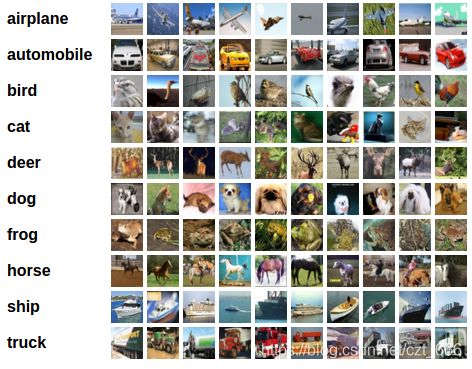训练一个分类器(Pytorch官方教程)
文章目录
-
- @[toc]
- 准备
- 数据
- 训练一个图像分类器
-
- 1.加载并规范化CIFAR10
- 展示一些训练图片
- 2. 定义卷积神经网络
- 3.定义损失函数和优化器
- 4.训练网络
- 5.测试网络
文章目录
-
- @[toc]
- 准备
- 数据
- 训练一个图像分类器
-
- 1.加载并规范化CIFAR10
- 展示一些训练图片
- 2. 定义卷积神经网络
- 3.定义损失函数和优化器
- 4.训练网络
- 5.测试网络
准备
下载Anaconda3并安装,ubuntu打开终端执行
bash Anaconda3-5.1.0-Linux-x86_64.sh
安装完成执行
conda install pytorch-gpu=1.3 torchvision=0.4
详细安装过程
数据
当需要处理图像、文本、音频或视频数据时,可以使用标准的python包将数据加载到numpy数组中。然后你可以把这个数组转换成torch.*Tensor。
对于视觉,torchvision包含用于常见数据集(如Imagenet、CIFAR10、MNIST等)的数据加载器和用于图像的数据转换器,即torchvision.datasets和torch.utils.data.DataLoader。
在本教程中,我们将使用CIFAR10数据集。它的类别有:“飞机”、“汽车”、“鸟”、“猫”、“鹿”、“狗”、“青蛙”、“马”、“船”、“卡车”(‘airplane’,‘automobile’, ‘bird’, ‘cat’, ‘deer’, ‘dog’, ‘frog’, ‘horse’, ‘ship’, ‘truck’)。CIFAR-10中的图像大小为3x32x32,即大小为32x32像素的3通道彩色图像。
训练一个图像分类器
我们将按顺序执行以下步骤:
- 使用
torchvision加载并规范化CIFAR10训练和测试数据集 - 定义一个卷积神经网络
- 定义损失函数
- 根据训练数据训练网络
- 在测试数据上测试网络
1.加载并规范化CIFAR10
使用torchvision,装载CIFAR10非常容易。
torchvision数据集的输出是范围为[0,1]的PILImage图像。我们把它们转换成归一化范围[-1,1]的张量。
打开项目文件夹,右键打开终端,执行
touch TrainingClassifiter.py && gedit TrainingClassifiter.py
//拷贝`下载数据代码`并保存,再执行
python TrainingClassifiter.py
//数据data 下载至项目文件夹
下载数据代码
import torch
import torchvision
import torchvision.transforms as transforms
transform = transforms.Compose(
[transforms.ToTensor(),
transforms.Normalize((0.5, 0.5, 0.5), (0.5, 0.5, 0.5))])
batch_size = 4
trainset = torchvision.datasets.CIFAR10(root='./data', train=True,
download=True, transform=transform)
trainloader = torch.utils.data.DataLoader(trainset, batch_size=batch_size,
shuffle=True, num_workers=2)
testset = torchvision.datasets.CIFAR10(root='./data', train=False,
download=True, transform=transform)
testloader = torch.utils.data.DataLoader(testset, batch_size=batch_size,
shuffle=False, num_workers=2)
classes = ('plane', 'car', 'bird', 'cat',
'deer', 'dog', 'frog', 'horse', 'ship', 'truck')
展示一些训练图片
执行命令
gedit TrainingClassifiter.py
//添加显示图片代码并保存,再执行
python TrainingClassifiter.py
显示图片代码
import matplotlib.pyplot as plt
import numpy as np
# functions to show an image
def imshow(img):
img = img / 2 + 0.5 # unnormalize
npimg = img.numpy()
plt.imshow(np.transpose(npimg, (1, 2, 0)))
plt.show()
# get some random training images
dataiter = iter(trainloader)
images, labels = dataiter.next()
# show images
imshow(torchvision.utils.make_grid(images))
# print labels
print(' '.join('%5s' % classes[labels[j]] for j in range(batch_size)))
2. 定义卷积神经网络
import torch.nn as nn
import torch.nn.functional as F
class Net(nn.Module):
def __init__(self):
super().__init__()
self.conv1 = nn.Conv2d(3, 6, 5)
self.pool = nn.MaxPool2d(2, 2)
self.conv2 = nn.Conv2d(6, 16, 5)
self.fc1 = nn.Linear(16 * 5 * 5, 120)
self.fc2 = nn.Linear(120, 84)
self.fc3 = nn.Linear(84, 10)
def forward(self, x):
x = self.pool(F.relu(self.conv1(x)))
x = self.pool(F.relu(self.conv2(x)))
x = torch.flatten(x, 1) # 展平除批次外的所有尺寸
x = F.relu(self.fc1(x))
x = F.relu(self.fc2(x))
x = self.fc3(x)
return x
net = Net()
3.定义损失函数和优化器
import torch.optim as optim
criterion = nn.CrossEntropyLoss()
optimizer = optim.SGD(net.parameters(), lr=0.001, momentum=0.9)
4.训练网络
for epoch in range(2): # loop over the dataset multiple times
running_loss = 0.0
for i, data in enumerate(trainloader, 0):
# get the inputs; data is a list of [inputs, labels]
inputs, labels = data
# zero the parameter gradients
optimizer.zero_grad()
# forward + backward + optimize
outputs = net(inputs)
loss = criterion(outputs, labels)
loss.backward()
optimizer.step()
# print statistics
running_loss += loss.item()
if i % 2000 == 1999: # print every 2000 mini-batches
print('[%d, %5d] loss: %.3f' %
(epoch + 1, i + 1, running_loss / 2000))
running_loss = 0.0
print('Finished Training')
5.测试网络
我们通过训练数据集对网络进行了2次训练。但我们需要检查一下网络是否学到了什么。
我们将通过预测神经网络输出的类标签来检查这一点,并根据基本事实进行检查。如果预测是正确的,我们将样本添加到正确预测的列表中。
好的,第一步。让我们从测试集中显示一个图像以熟悉它。
dataiter = iter(testloader)
images, labels = dataiter.next()
# print images
imshow(torchvision.utils.make_grid(images))
print('GroundTruth: ', ' '.join('%5s' % classes[labels[j]] for j in range(4)))
接下来,让我们加载回我们保存的模型(注意:这里不需要保存和重新加载模型,我们这样做只是为了说明如何这样做):
net = Net()
net.load_state_dict(torch.load(PATH))
好的,现在让我们看看神经网络是怎么想的上面这些例子是:
outputs = net(images)
输出是10个类的能量。一个类的能量越高,网络就越认为该图像属于特定的类。那么,让我们得到最高能量的指数:
_, predicted = torch.max(outputs, 1)
print('Predicted: ', ' '.join('%5s' % classes[predicted[j]]
for j in range(4)))
结果看起来不错。
让我们看看网络在整个数据集上的表现。
correct = 0
total = 0
# since we're not training, we don't need to calculate the gradients for our outputs
with torch.no_grad():
for data in testloader:
images, labels = data
# calculate outputs by running images through the network
outputs = net(images)
# the class with the highest energy is what we choose as prediction
_, predicted = torch.max(outputs.data, 1)
total += labels.size(0)
correct += (predicted == labels).sum().item()
print('Accuracy of the network on the 10000 test images: %d %%' % (
100 * correct / total))
这看起来比偶然性要好得多,偶然性是10%的准确率(从10个类中随机挑选一个类)。网络好像学到了什么。
嗯,哪些课程表现好,哪些课程表现不好:
# prepare to count predictions for each class
correct_pred = {classname: 0 for classname in classes}
total_pred = {classname: 0 for classname in classes}
# again no gradients needed
with torch.no_grad():
for data in testloader:
images, labels = data
outputs = net(images)
_, predictions = torch.max(outputs, 1)
# collect the correct predictions for each class
for label, prediction in zip(labels, predictions):
if label == prediction:
correct_pred[classes[label]] += 1
total_pred[classes[label]] += 1
# print accuracy for each class
for classname, correct_count in correct_pred.items():
accuracy = 100 * float(correct_count) / total_pred[classname]
print("Accuracy for class {:5s} is: {:.1f} %".format(classname,
accuracy))
就像你把张量转移到GPU上一样,你把神经网络转移到GPU上。
让我们首先将我们的设备定义为第一个可见的cuda设备,如果我们有可用的cuda:
device = torch.device("cuda:0" if torch.cuda.is_available() else "cpu")
# Assuming that we are on a CUDA machine, this should print a CUDA device:
print(device)
本节的其余部分假设设备是CUDA设备。
然后这些方法将递归地遍历所有模块,并将其参数和缓冲区转换为CUDA张量:
net.to(device)
请记住,您还必须将每个步骤的输入和目标发送到GPU:
inputs, labels = data[0].to(device), data[1].to(device)
